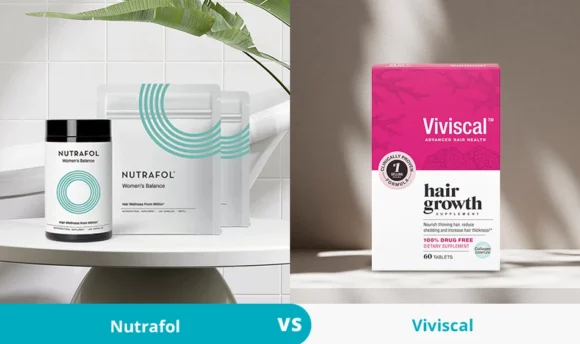Type 4b Hair (Coily): Styling Tips and How to Take Care of It
Like all curly hair types, 4b hair is unique in its appearance. You must care for it wisely to keep your coily locks in tip-top shape. Keep reading for the complete guide to maintaining beautiful 4b coils outside of the salon with some essential practices at home.

The hair typing system enables you to identify what kind of hair you have. Knowing your exact hair type means you can make the most of your natural tresses by implementing the best hair wash schedule, styling techniques, products, and haircuts for a gorgeous mane.
Type 4b hair falls into the coily hair category – a group that demands a certain level of care. It differs significantly from straight and wavy hair types and is typically more tricky to control. But that doesn’t mean you can’t enjoy your type 4b hair and maximize its potential at every turn.
This article focuses solely on type 4b hair to guide those with this unique curl pattern.
What Is Type 4b Hair?
Type 4b hair falls between the 3 coily hair types. The hair strands have sharp angles that form a Z-shape and an overall zigzag pattern, differing from the S-shape pattern of type 4a hair. The coils are usually coarse in texture, packed tightly together, and often appear fluffy.
Despite the noticeable zigzag pattern, the 4b curl shape often lacks definition. This hair type also shrinks significantly when transitioning from the wet to dry state.
Pros of type 4b hair
There are a few perks to having type 4b hair. With proper care and a routine explicitly prepared for your hair type, your coils will thrive, and you can begin to appreciate your hair’s natural beauty.
Here’s what you can love about your coily hair.
- Plenty of volume: Kinky hair has an abundance of volume. You don’t need to pile on the styling products to increase the body of this hair type, as it’s a key characteristic of your natural hair. It grows horizontally, creating an energetic mane that never appears flat or lackluster.
- You don’t need to cleanse often: Since the curl pattern features a lot of bends and sharp angles, the scalp’s natural oils struggle to coat the strands all the way through. This causes dry hair, but the upside is that you don’t have to wash it very often to combat oiliness. Your hair can continue to look great for up to a week.
- You can play with styles: Some people think type 4b hair is tough to manage, but you can actually have a lot of fun with this hair type. Many easy hairstyles emphasize the voluminous curl patterns, from pinning it up in a messy pineapple to adding an embellished headband or colorful scarf.
Cons of type 4b hair
Despite the many benefits, type 4b hair has its fair share of flaws. Many people with this curl type face common complaints that can make everyday styling feel like a chore. These include:
- Lack of curl definition: Type 4b hair is the second tightest curl pattern of all hair types, but it often lacks definition. These coils are tightly wrapped, and the zigzag pattern makes the overall hair look more fluffy than curly.
- Dryness and frizz: All curly hair types are prone to dryness and frizz because the natural oils from the scalp cannot travel easily from roots to ends. You can’t rely on your natural hair to retain moisture, but you can counter this problem with a good haircare routine that keeps the hair hydrated.
- Lots of shrinkage: Due to the tight coils, type 4b hair shrinks significantly when it goes from wet to dry. That means it looks much shorter than it is, regardless of hair growth. Shrinkage is a sign of healthy hair, but it can make it difficult to enjoy your longer locks.
How to Take Care of Type 4b Hair: 7 Tips and Tricks
You can maximize the advantages and combat the drawbacks with a haircare system customized for your type 4b hair. Try the following tips to maintain long-term hair health.
#1 Don’t underestimate moisturization
Your type 4b hair needs additional moisture because it can’t retain enough moisture alone. Making moisturization an essential step throughout your haircare plan is incredibly beneficial. It will help keep the hair soft, less frizzy, and easier to tame.
You can add moisture continuously, starting with a moisturizing shampoo. Then there’s the everyday conditioner you use after shampooing, leave-in conditioner, hair oil, and styling cream. The combination of these products will seal in as much moisture as possible.
Don’t forget to deep condition regularly. A potent deep conditioning treatment puts intense moisture back into the hair.
#2 Wash in sections
Washing your coily hair in sections can make for a more manageable routine. It helps prevent tangling and ensures that the shampoo is evenly distributed throughout the hair for a thorough cleanse. It’s crucial for coily hair types that require less frequent washes.
Washing too often can dry your hair out even more. You’ll lose the natural sebum from your scalp that keeps your hair healthy and moisturized. Even if you have an active lifestyle that promotes sweating, you can still go a few days without shampooing.
#3 Cleanse and nourish your scalp
Cleansing the scalp rids it of dirt, debris, and excess oils.
Your scalp condition can influence your hair’s overall health, from slowing hair growth to triggering hair loss. Regardless of your hair type, poor scalp care can cause buildup that blocks the hair follicles, causing inflammation, itchiness, dandruff, and scalp disorders.
You can mitigate common hair problems by cleansing and nourishing your scalp with natural products comprising gentle and moisturizing ingredients. You can also give yourself a scalp massage, consume more antioxidants, and avoid products with sulfates and other irritants.
#4 Lengthen your curls
Shrinkage is a common complaint among people with coily hair, but there are ways to maintain length as your curls dry. A loose braid is one of the easiest ways to relax and stretch your curls. Divide your wet hair into 3 sections and braid loosely.
You can also try Bantu knots, the pineapple method, and ballerina buns to lengthen tight curls.
#5 Detangle with fingers
Some people prefer a wide-tooth comb, but detangling wet hair with your fingers is one of the best techniques to protect your mane from breakage. Simply coat your strands in a conditioner to decrease friction and begin separating and unwinding your curls in the shower.
#6 Go for gentle hairstyles
Gentle hairstyles are good for all hair types because they remove extra stress on the scalp and hair roots that can lead to hair loss and shedding. They are particularly beneficial for tight, coily hair textures at greater risk of hair loss from traction alopecia.
Avoiding tight hairstyles is the best protection against the condition. Turn your attention to protective styles like box braids, loose plaits, and messy buns that look good without pulling on the strands.
#7 Protect your hair at night
Wearing protective styles at bedtime can help protect your curls from damage as you toss and turn while you sleep. Loose braids, twists, and the pineapple style will help keep your curls intact overnight. Wrapping your hair in a silk scarf is another easy way to prepare for sleep.
You might also consider changing your bedding. A satin pillowcase, for example, will keep your hair from getting caught when you move.
What Hairstyles Are Ideal for Type 4b Hair?
You can explore different looks when you have type 4b hair because it is versatile. This could mean getting a new haircut at the salon or simply styling your hair differently. The important thing is to avoid over-styling your hair, as this can cause damage.
Many like to stick to the best protective styles for type 4b hair to prevent breakage. These include:
- Box braids: Box braids can reduce shrinkage and give your hair length.
- Bantu knots: These knots help to retain moisture and combat frizz.
- Messy bun: A messy bun creates a voluminous hairstyle with minimal effort.
- Twist outs: Twist outs help retain moisture and boost curl definition.
- The pineapple: Great for protecting your curls while you sleep, but it also creates a unique daytime or evening look.
Some of the best haircuts for type 4b hair include:
- Bouncy bob: A bob gives your hair more bounce and shape.
- Chic pixie cut: This cut allows you to embrace your natural hair with little maintenance.
- Layered afro: Layers add bounce, movement, shape, and definition.
How to define type 4b curls
The trick to defining type 4b curls, or any curls for that matter, is to lock in moisture. Strands that are too dry are more likely to lose their shape and become frizzy as they absorb moisture from the air. So you need to limit this occurrence with products that help retain moisture.
Start with a moisturizing shampoo and conditioner before adding a leave-in conditioner. You can then add curl-defining products while the hair is still wet to give your type 4b hair the best chance to transform into well-defined curls.
Hair oils also add shine and energy to curls. You could try almond oil, castor oil, or coconut oil for the best results.
Best Hair Products for Type 4b Hair
There’s no denying the importance of hair products in any haircare routine. For the best results with type 4b hair, choose natural ingredients with moisturizing properties. They will help combat dryness, frizz, and poor coil definition.
Aim to include the following ingredients somewhere in your regimen:
- Avocado and avocado oil
- Coconut oil
- Mango butter
- Pumpkin seed oil
- Shea butter
- Soybean oil
You can discover a range of gentle products with beneficial ingredients, whether you’re looking for a hair butter or leave-in moisturizer.
You should always appreciate the importance of your shampoo’s ingredients, too. The Moérie Mineral Shampoo is a good choice for type 4b hair because it contains betaine, biotin, caffeine, and fulvic acid to cleanse the scalp, improve scalp condition, and stimulate hair growth.
FAQs
Type 4b hair is very dry and doesn’t tend to get oily on the scalp. Therefore, you don’t need to wash your type 4b hair often to keep it clean. It’s best to wash as little as possible to protect against dryness and minimize breakage – once or twice a week is usually enough.
You can tell the difference by looking at the curl pattern and the tightness of the coils. Type 4b hair has thick strands that form a zigzag pattern, while type 4c hair has tighter coils with a Z-pattern that can be difficult to see.
Type 4b hair is often frizzy because it is very prone to dryness. The tightly coiled texture has difficulty holding onto moisture, causing the hair cuticles to absorb excess moisture from the environment. The hair shaft then swells and changes shape, resulting in frizzy hair.
A Word From a Trichologist
Type 4b is the second coily hair type in the hair typing system. It differs from the other type 4 subtypes because it has coarse, distinctive zigzag patterns and a fluffy texture that some describe as cotton candy. You can manage this unique curl pattern with the right techniques and care system.
Top hair tips for luscious type 4b hair include moisturizing, detangling, washing in sections, and wearing a protective style overnight.
Remember to fill your diet with healthy foods that deliver nutrients to the hair and scalp while preventing nutrient deficiency and hair loss.
Conclusion
Type 4b hair requires a little more work to look its best, but with the right care routine, your natural hair will be more manageable. The big problem with this hair type is that it doesn’t hold moisture very well, making it prone to breakage and frizzy flyaways.
But the solution is simple – you need to replenish moisture with daily care. Fill your regimen with moisturizing ingredients wherever possible, from your basics (shampoo and conditioner) to your hair oils, deep conditioners, and hair masks.

















































 Select your language:
Select your language: 








